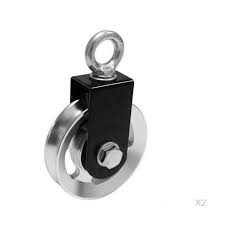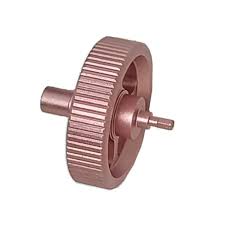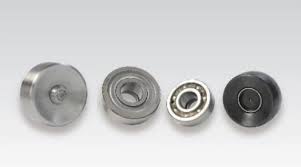Product Description
Custom pulley Spinning taper cast belt idler sheaves and pulleys interchange with driven brass metal multiple stainless steel flat mount nylon taper lock step
A single adjustable pulley is a type of pulley that can be adjusted to change the direction of the force applied to it. This makes it a versatile tool that can be used for various applications.
Some of the most common applications for single adjustable pulleys include:
- Lifting: Single adjustable pulleys can be used to lift heavy objects. By changing the direction of the force, you can multiply your lifting power.
- Pulling: Single adjustable pulleys can be used to pull objects. This is useful for tasks such as moving furniture or loading a truck.
- Tensioning: Single adjustable pulleys can be used to tension cables or strings. This is useful for tasks such as setting up a hammock or securing a load.
- Supporting: Single adjustable pulleys can be used to support objects. This is useful for tasks such as suspending a work light or holding a ladder in place.
Single adjustable pulleys are versatile and useful tool that can be used for various applications. If you are looking for a way to multiply your lifting power, pull objects, tension cables, or support objects, then a single adjustable pulley is a good option.
Here are some additional benefits of using single adjustable pulleys:
- They are relatively inexpensive.
- They are easy to install and use.
- They are durable and can withstand a lot of wear and tear.
- They are versatile and can be used in a variety of applications.
If you are looking for a reliable and efficient way to lift, pull, tension, or support objects, then a single adjustable pulley is a good option.
| Certification: | CE, ISO |
|---|---|
| Pulley Sizes: | Type F |
| Manufacturing Process: | Forging |
| Material: | Carbon Steel |
| Surface Treatment: | Baking Paint |
| Application: | Chemical Industry, Grain Transport, Mining Transport, Power Plant |
| Samples: |
US$ 9999/Piece
1 Piece(Min.Order) | |
|---|

How are spinning pulleys customized for specific machinery and equipment?
Spinning pulleys can be customized to suit the specific requirements of machinery and equipment. Here’s an overview of the customization process and the factors involved:
1. Design Considerations:
Customizing spinning pulleys begins with a careful assessment of the machinery or equipment’s operational needs and constraints. Design considerations include factors such as power requirements, rotational speed, torque specifications, space limitations, and environmental conditions.
2. Material Selection:
The choice of material for spinning pulleys depends on the application’s demands. Common materials include metals like steel or aluminum for their strength and durability. Other factors considered during material selection include corrosion resistance, weight, cost, and specific industry requirements.
3. Pulley Geometry:
The geometry of the spinning pulley is tailored to the machinery’s requirements. This involves determining the pulley’s diameter, width, groove shape (V-shaped, flat, round), and the number of grooves (for multiple belt systems). The dimensions and shape of the pulley are optimized to ensure proper belt tracking, tension, and grip.
4. Shaft Compatibility:
Customized spinning pulleys need to be compatible with the machinery’s shaft or spindle. This involves considering factors such as shaft diameter, keyway specifications, and mounting requirements. The pulley is designed to securely fit onto the shaft and facilitate efficient power transmission.
5. Belt or Rope Compatibility:
The spinning pulley must be compatible with the type and size of the belt, rope, or cable used in the system. Factors such as belt width, thickness, and material (rubber, fabric, steel) are taken into account. The pulley’s groove dimensions and shape are optimized to ensure proper belt fit and prevent slippage.
6. Surface Treatment:
In some cases, spinning pulleys may undergo surface treatments to enhance their performance or address specific requirements. Surface treatments can include coating, plating, or heat treatment processes to improve wear resistance, reduce friction, or provide protection against environmental factors like corrosion or extreme temperatures.
7. Quality Assurance:
Customized spinning pulleys undergo rigorous quality assurance processes to ensure they meet the desired specifications and performance standards. This may involve testing for dimensional accuracy, material strength, balance, and overall functionality. Quality control measures are implemented to deliver reliable and high-quality pulleys.
8. Collaboration with Manufacturers:
Customizing spinning pulleys often involves collaboration between machinery manufacturers and pulley suppliers or manufacturers. The manufacturers work closely with the machinery designers or engineers to understand the specific requirements and provide customized solutions that align with the machinery’s overall design and performance objectives.
By considering these factors and collaborating with manufacturers, spinning pulleys can be customized to fit seamlessly into specific machinery and equipment, ensuring optimal power transmission, reliability, and longevity.

What safety considerations should be kept in mind when working with spinning pulleys?
Working with spinning pulleys requires careful attention to safety to prevent accidents or injuries. Here are some important safety considerations to keep in mind:
1. Personal Protective Equipment (PPE):
Wear appropriate PPE, such as safety glasses, gloves, and protective clothing, to protect yourself from potential hazards like flying debris, pinch points, or entanglement.
2. Lockout/Tagout Procedures:
Before performing any maintenance or adjustment tasks on systems or machinery involving spinning pulleys, follow lockout/tagout procedures to isolate the power source and prevent unexpected startup or movement.
3. Proper Installation and Maintenance:
Ensure that spinning pulleys are properly installed, aligned, and maintained according to manufacturer instructions. Regularly inspect for wear, damage, or misalignment and address any issues promptly.
4. Belt Tension and Alignment:
Maintain proper belt tension and alignment to prevent belt slipping or derailment. Improper tension or alignment can cause sudden movement or dislodgment of the belt, leading to potential accidents.
5. Guarding and Enclosures:
Install appropriate guards or enclosures around spinning pulleys to prevent accidental contact with moving parts. This helps to minimize the risk of entanglement or injury.
6. Training and Knowledge:
Ensure that individuals working with spinning pulleys have received proper training and are knowledgeable about the associated hazards and safe operating procedures. This includes understanding emergency shutdown procedures and knowing how to respond to potential incidents.
7. Clear Work Area:
Maintain a clean and uncluttered work area around spinning pulleys to reduce the risk of trips, falls, or inadvertent contact with moving parts.
8. Power Isolation:
When performing maintenance or repair tasks, ensure that the power supply to the system or machinery is completely isolated to prevent accidental startup or movement.
9. Follow Manufacturer Guidelines:
Adhere to the manufacturer’s specific guidelines and recommendations for the safe use and operation of spinning pulleys. Manufacturers often provide safety instructions and precautions that are specific to their products.
10. Risk Assessment:
Conduct a thorough risk assessment of the task or system involving spinning pulleys to identify and mitigate potential hazards. Consider factors such as speed, torque, pinch points, and entanglement risks.
Remember, safety should always be a priority when working with spinning pulleys. By following these safety considerations and using common sense, you can minimize the risk of accidents and create a safer working environment.

Can you explain the key components and design features of a spinning pulley?
A spinning pulley consists of several key components and design features that allow it to function effectively in mechanical systems. Here’s a detailed explanation of these components and features:
1. Hub:
The hub is the central part of the spinning pulley. It is typically a solid cylindrical structure that provides support and stability to the pulley. The hub is mounted on a shaft or axle, allowing the pulley to rotate freely.
2. Rim or Groove:
The rim or groove is the outer edge of the spinning pulley. It is specifically designed to accommodate a rope, belt, or cable. The rim is usually rounded or flat, depending on the application. Its primary function is to guide and retain the rope or belt during operation, preventing slippage and ensuring efficient power transmission.
3. Diameter:
The diameter of a spinning pulley refers to the distance across its outer rim. It plays a crucial role in determining the speed and mechanical advantage of the pulley system. Larger diameters result in increased speed but reduced mechanical advantage, while smaller diameters provide higher mechanical advantage at the expense of speed.
4. Material:
Spinning pulleys are typically made from durable materials such as metal, plastic, or composite materials. The choice of material depends on factors such as the load capacity, environment, and specific application requirements. Metal pulleys, such as steel or aluminum, are commonly used in heavy-duty applications, while plastic or composite pulleys are preferred in lighter-duty or corrosive environments.
5. Bearings:
Bearings are essential components in spinning pulleys as they enable smooth rotation. They reduce friction between the rotating hub and the shaft, allowing the pulley to spin with minimal resistance. Common types of bearings used in spinning pulleys include ball bearings and roller bearings.
6. Mounting Mechanism:
Spinning pulleys are typically mounted on a shaft or axle, which allows them to rotate freely. The mounting mechanism may involve set screws, keyways, or other fastening methods to secure the pulley to the shaft. The design of the mounting mechanism should ensure proper alignment and prevent slippage during operation.
7. Flanges:
Some spinning pulleys feature flanges on either side of the rim. Flanges are raised edges or rims that help keep the rope or belt aligned and prevent it from slipping off the pulley during operation. Flanges provide additional guidance and stability, particularly when the pulley is subjected to lateral forces or when the rope or belt is under tension.
8. Tensioning Mechanism:
In certain applications, spinning pulleys may include a tensioning mechanism. This mechanism allows for the adjustment of tension in the rope or belt, ensuring optimal performance and preventing slippage. Tensioning mechanisms can involve springs, levers, or other devices that allow for easy adjustment and maintenance of tension.
These are the key components and design features of a spinning pulley. The combination of these elements enables the pulley to effectively transmit power, change the direction of force, and create mechanical advantage in various mechanical systems.


editor by CX
2023-10-05